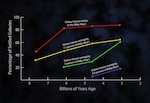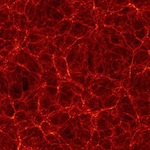Word doc
PDF (formatted and ready to go as a single newsletter page)
Magnetically Levitating Black Holes
Lurking in the centers of most galaxies, including our own Milky Way, are supermassive black holes: monsters from several hundred thousand to several billion solar masses jammed into a volume equivalent to that of our solar system. Gas or stars drifting too close will find themselves caught in the grip of the powerful gravitational field, trapped in an inexorable death spiral ever faster and tighter down toward the black hole, until voraciously consumed in a last gasp of electromagnetic radiation. Right?

A computer simulation shows gas (yellow) falling in the direction of a central black hole (too small to be seen). Twin jets (blue), strongly focused by spiral magnetic field lines, shoot out towards the top and bottom, perpendicular to the plane of the rotating accretion disk. Credit: Alexander Tchekhovskoy / LBNL
Not so fast. A new study of 76 supermassive black holes, combining analysis of observations with computer simulations, reveals that some galactic behemoths have magnetic fields powerful enough to counteract the enormous pull of their gravity—thereby allowing clouds of gas or other objects at the top of the magnetic fields to levitate temporarily in place above a supermassive black hole.
“This paper for the first time systematically measures the strength of magnetic fields near black holes,” said co-author Alexander Tchekhovskoy, a Lawrence Berkeley National Laboratory (LBNL) postdoctoral researcher who helped interpret observations within the context of computational models. “Now we have evidence from not just one or two, but from 76 black holes.”
Loud and twisted
Of interest are blazars: active galactic nuclei (AGNs) that beam extremely bright, energetic, collimated jets of gas at nearly the speed of light in the direction of the Earth. Such jets—which shoot out along the axis of rotation of a disk of gas accreting around a rotating black hole—emit powerful radiation at radio wavelengths. Only about one in ten AGNs have powerful radio-emitting jets.
From such radio emission independently observed by other astronomers at different frequencies using very long baseline interferometry (VLBI) from a vast network radio telescopes separated by thousands of miles, the authors determined the strengths of magnetic fields threading through the jets and central black holes of 68 blazars and eight nearby radio galaxies. Included were such famous galaxies as the beautiful spiral Messier 81 in Ursa Major, Centaurus A (the radio galaxy nearest to our Milky Way), and Cygnus A (a famous radio galaxy discovered in 1939 by radio astronomy pioneer Grote Reber).
The coauthors compared the predictions of the computer simulations to the measured magnetic field strengths and found good agreement. The simulations revealed that the magnetic fields, which are twisted by the rotation of a supermassive black hole, are strong enough to counteract the pull of gravity and retard the infall of gas. The twist also transfers black hole rotational energy to electromagnetic energy of the jets, which carry it out as far as several light-years away.
A heavy fluid (accreting gas) placed on top of a light fluid (a magnetic field) is an unstable configuration because the two fluids naturally want to change places, Tchekhovskoy explains. However, for a few hours, “the gas is slowed down by the presence of magnetic fields and even sometimes briefly stopped,” he says, so that the gas “continuously trickles down to the black hole” instead of falling unobstructed.
Back to the drawing board
Thus, “…the jet-launching regions of these radio-loud galaxies are threaded by dynamically important [magnetic] fields, which will affect the disk properties,” the authors conclude. “These fields obstruct gas infall, compress the accretion disk vertically, slow down the disk rotation by carrying away its angular momentum in an outflow, and determine the directionality of jets.”
Tchekhovskoy and his three coauthors from the Max Planck Institute for Radio Astronomy in Bonn, Germany, believe that the new results mean theorists must re-evaluate their understanding of how supermassive black holes behave.–Trudy E. Bell, M.A.
The paper, “Dynamically important magnetic fields near accreting supermassive black holes,” by M. Zamaninasab, Eric Clausen-Brown, T. Savolainen, and Alexander Tchekhovskoy, published in Nature on June 5, 2014, is accessible from http://www.nature.com/nature/journal/v510/n7503/full/nature13399.html . A press release from LBNL is at http://newscenter.lbl.gov/2014/06/04/black-holes/ and a release from the Max Planck Institute is at http://www.mpg.de/8256277/magnetic-fields_supermassive-black-holes.
The University of California High-Performance AstroComputing Center (UC-HIPACC), based at the University of California, Santa Cruz, is a consortium of nine University of California campuses and three Department of Energy laboratories (Lawrence Berkeley Laboratory, Lawrence Livermore Laboratory, and Los Alamos National Laboratory). UC-HiPACC fosters collaborations among researchers at the various sites by offering travel and other grants, co-sponsoring conferences, and drawing attention to the world-class resources for computational astronomy within the University of California system. More information appears at http://hipacc.ucsc.edu .




















